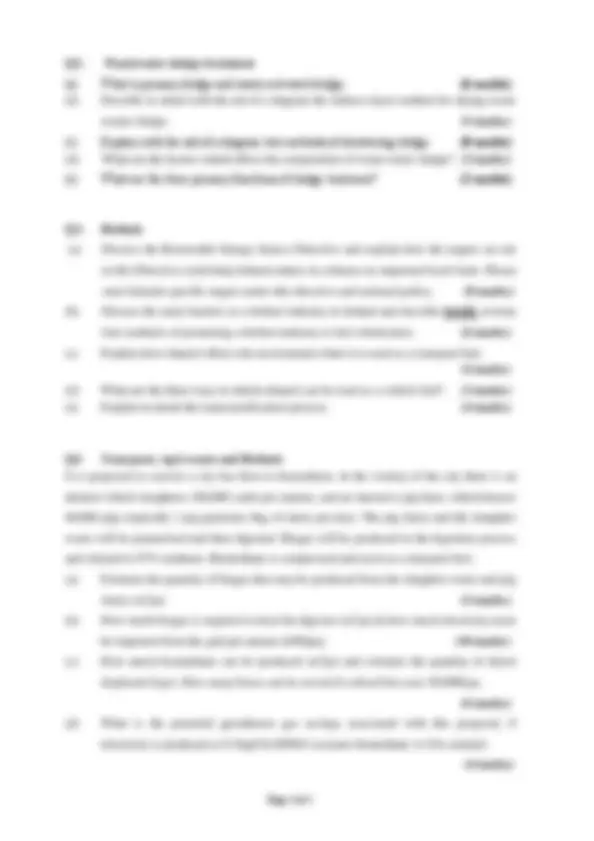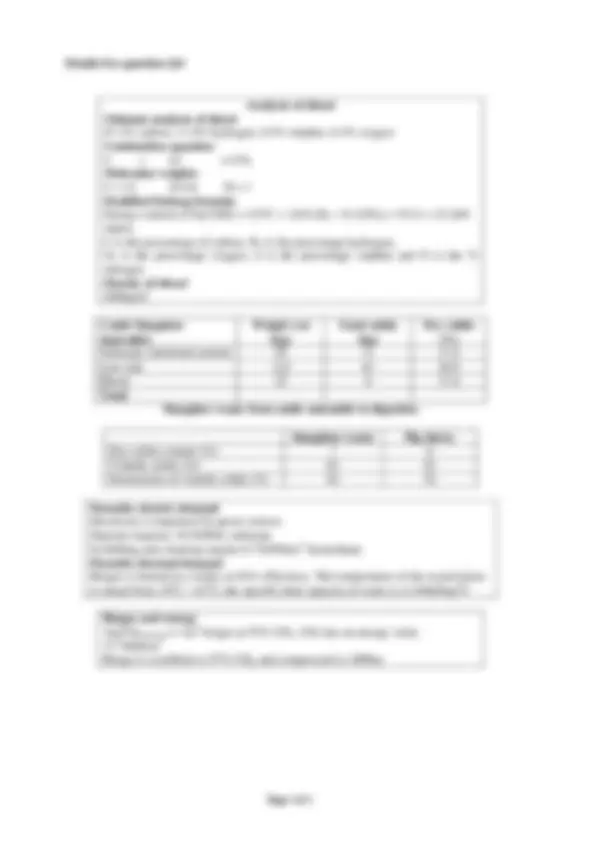




Study with the several resources on Docsity

Earn points by helping other students or get them with a premium plan


Prepare for your exams
Study with the several resources on Docsity

Earn points to download
Earn points by helping other students or get them with a premium plan
Community
Ask the community for help and clear up your study doubts
Discover the best universities in your country according to Docsity users
Free resources
Download our free guides on studying techniques, anxiety management strategies, and thesis advice from Docsity tutors
Main points of this past exam are: Municipal Solid Waste, Treatment of Organic Fraction, Economic Parameter, Anaerobic Digestion, Minimum Gate Fee, Quantity of Kerosene, Thermal Energy, Landfilling Waste, Wastewater Sludge Treatment
Typology: Exams
1 / 4

This page cannot be seen from the preview
Don't miss anything!



Semester 1 Examinations 2012/
Module Code: CIVL
School: Civil, Strutural and Environmental Engineering
Programme Title: Bachelor of Engineering (Hons) in Structural Engineering Certificate in Environmental & Energy Engineering Bachelor of Engineering (Hons) in Sustainable Energy
Programme Code: CSTRU_8_Y EENEN_8_Y ESENT_8_Y
External Examiner(s): Dr Roger West, Mr Jack O’ Leary Internal Examiner(s): Dr N. Power
Instructions: Answer all questions.
Duration: 2 Hours
Sitting: Winter 2012
Requirements for this examination:
Note to Candidates: Please check the Programme Title and the Module Title to ensure that you have received the correct examination paper. If in doubt please contact an Invigilator.
Q1. Treatment of the organic fraction of municipal solid waste An area has a population of 415,000pe. The MSW production is 667kg/pe, 42% of which may be sent to a composting/anaerobic digestion facility. Both facilities produce compost. The waste has a dry solids content of 39%, a volatile solids content of 61%, with 52% of volatiles destroyed in the digester. Digestate/compost is produced at 61% solids. The biogas from the anaerobic digester may be used in a CHP facility. Electricity is produced at 36% efficiency (parasitic demand 31%) and thermal energy is produced at 44% efficiency (parasitic demand 9%). The destruction of 1kg of volatile solids results in the production of 1m^3 of biogas with a methane content of 52%. Composting requires an electrical input of 34kWeh/t of organic waste and a diesel requirement of 1.9L/t.
Economic Parameter Quantity Capital cost of digester incl. CHP €239/tpa Capital cost of composting €137/tpa Operating cost of digester incl. CHP €28/t Operating cost of composting €26/t Cost of electricity €0.16/kWh Cost of diesel (after VAT rebate) €1.00/L Sale of electricity €0.13/kWh Sale of heat €0.03/kWh Sale of compost/digestate €9/t
(a) How much compost/digestate is produced from the processes. (2 marks) (b) How much electricity may be exported from the digester in units of kWhpa? If an average house uses 4,792kWhpa, how many houses may be served? (6 marks) (c) How much heat may be exported from the digester in units of kWhpa? If an average house uses 69GJpa of thermal energy, how many houses may be served? (3 marks) (d) The capital cost is spread over 20 years with a return on investment of 8%. Determine the minimum gate fee required for the Composting and CHP facility. (8 marks) (e) Estimate the quantity of kerosene that would be saved if the heat from the CHP were used to heat houses. Kerosene has an energy value of 42.1GJ/t, a density of 840kg/m^3 and operates at 92% efficiency. Express your answer in units of Lpa. (2 marks) (f) Calculate the net greenhouse gas saving for CHP only , expressing your answer in tCO 2 pa. Assume, the ‘do nothing scenario’ of landfilling waste saves 0.8tCO 2 /t waste, 1m^3 biogas burned produces 1.96kgCO 2 /m^3 , ESB produce electricity at 0.513tCO 2 /MWh; 1t kerosene emits 3.17tCOpa. (4 marks)
Details for question Q
Analysis of diesel Ultimate analysis of diesel 87.2% carbon, 11.4% hydrogen, 0. 5 % sulphur, 0. 3 % oxygen Combustion equation C + O 2 = CO 2 Molecular weights C = 12 O=16 H = 1 Modified Dulong formula Energy content of fuel MJ/t = 337C + 1419 (H 2 – 0.125O 2 ) + 93 S + 23.26N where, C is the percentage of carbon, H 2 is the percentage hydrogen, O 2 is the percentage oxygen, S is the percentage sulphur and N is the % nitrogen. Density of diesel 84 0kg/m^3 Cattle Slaughter (kg/cattle)
Weight wet (kg)
Total solids (kg)
Dry solids (%) Stomach, intestinal content 95 11 1 1. Low risk 122 41 3 0. Blood 23 4 17. Total Slaughter waste from cattle amenable to digestion Slaughter waste Pig slurry Dry solids content (%)? 6 Volatile solids (%) 81 81 Destruction of volatile solids (%) 83 52 Parasitic electric demand Electricity is imported for green sources Digester requires 10.5kWh/t substrate Scrubbing and cleaning require 0.7 5 kWh/m^3 biomethane Parasitic thermal demand Biogas is burned in a boiler at 92% efficiency. The temperature of the waste/slurry is raised from 10 oC – 63 oC; the specific heat capacity of water is 4.184kJ/kg/oC Biogas and energy 1kgVSdestroyed = 1m^3 biogas at 5 5 % CH 4. CH 4 has an energy value 37.78MJ/m^3 Biogas is scrubbed to 97% CH 4 and compressed to 200bar